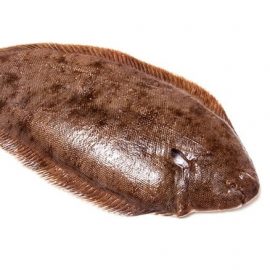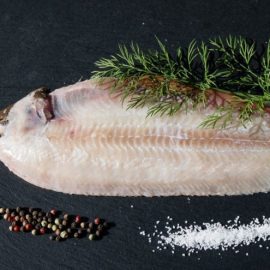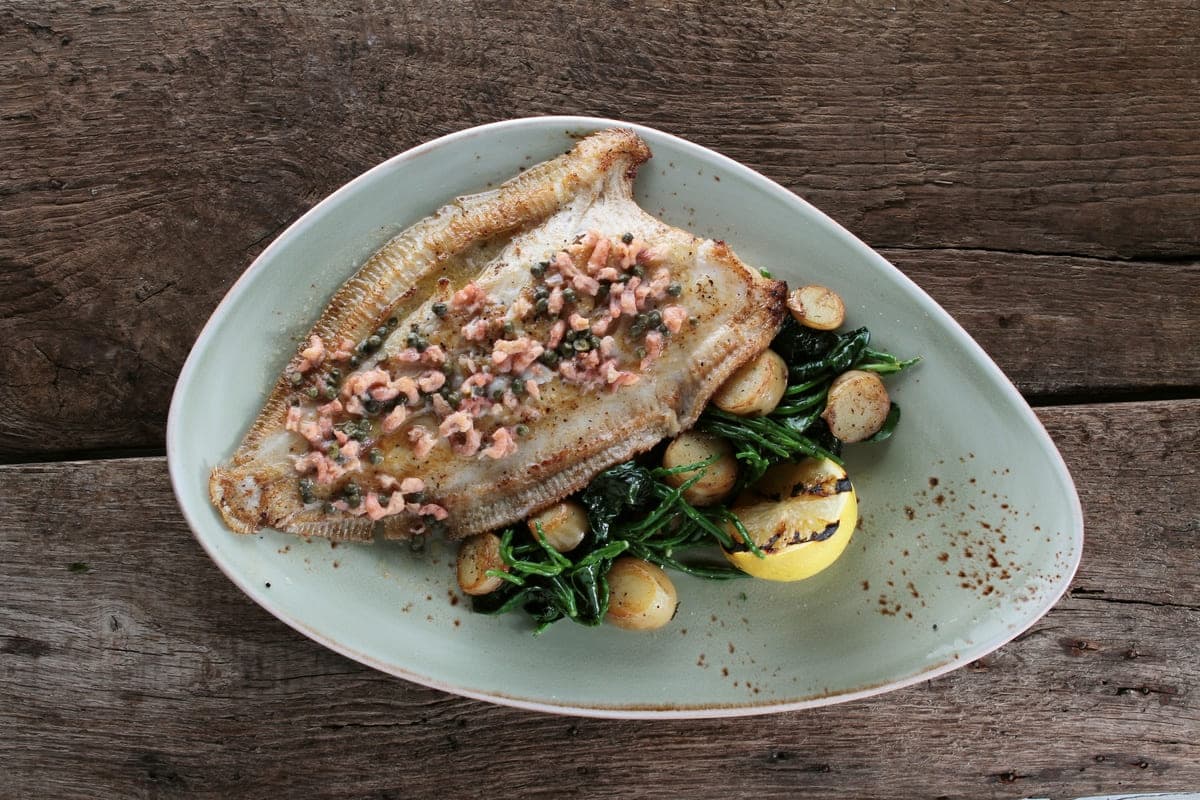
Introduction
Dover Sole (Solea solea), known as ‘Common Sole’, is a small bottom-dwelling flatfish found in the Pacific and Atlantic Oceans. It is highly prized as a food fish. It is favoured for its delicate white flesh boasting a mild flavour and versatility, making it a popular ingredient in restaurants, home kitchens, and traditional dishes throughout Britain, France and Northern Europe.
Description
Dover Sole is a species of flatfish belonging to the Soleidae family. It was discovered in Dover, England, where it gets its name.
The only member of its genus Solea, Dover Sole, is part of the class Actinopterygii and is one of two genera currently in the Soleidae family. The Dover Sole is sometimes referred to as the King of Soles due to its premium quality or the Queen of Soles in certain regions – the latter is reserved for the Plaice.
Physical Characteristics
The most common maximum length for a Dover Sole is around 30 cm, with a maximum weight of up to 500 g. The eyes of a Dover Sole are located on the right side of the head, unlike other flatfish species, and its mouth is at the front of the head, equipped with small sharp teeth.
Along its dorsal fin are several spiny rays, a distinguishing feature of the Dover Sole. Its anal fin extends the entire length of its back, and there may be black margins on the fins. It also has two long barbels on the chin, indicating the taste buds’ presence. The Dover Sole is typically white or nearly white on the underside and lacks the spotted pattern.
Females are typically larger than males, and Dover sole is distinguished from other flatfishes by the presence of three spines on their dorsal fin.
It is highly sought after for its mild and delicate flavour and juicy white flesh and is widely considered a delicacy due to its prized firm texture and moist flesh.
Habitat
The species can be found in depths of 0-200 meters in various habitats, such as shallow sand, muddy bottoms, and deeper waters in the English Channel and the Celtic Sea.
They prefer to dwell in sandy-gravely areas and feed in estuaries and rivers. Young Dover sole tends to stay close to the edges of the continental shelf, while mature specimens favour depths more than 200m.
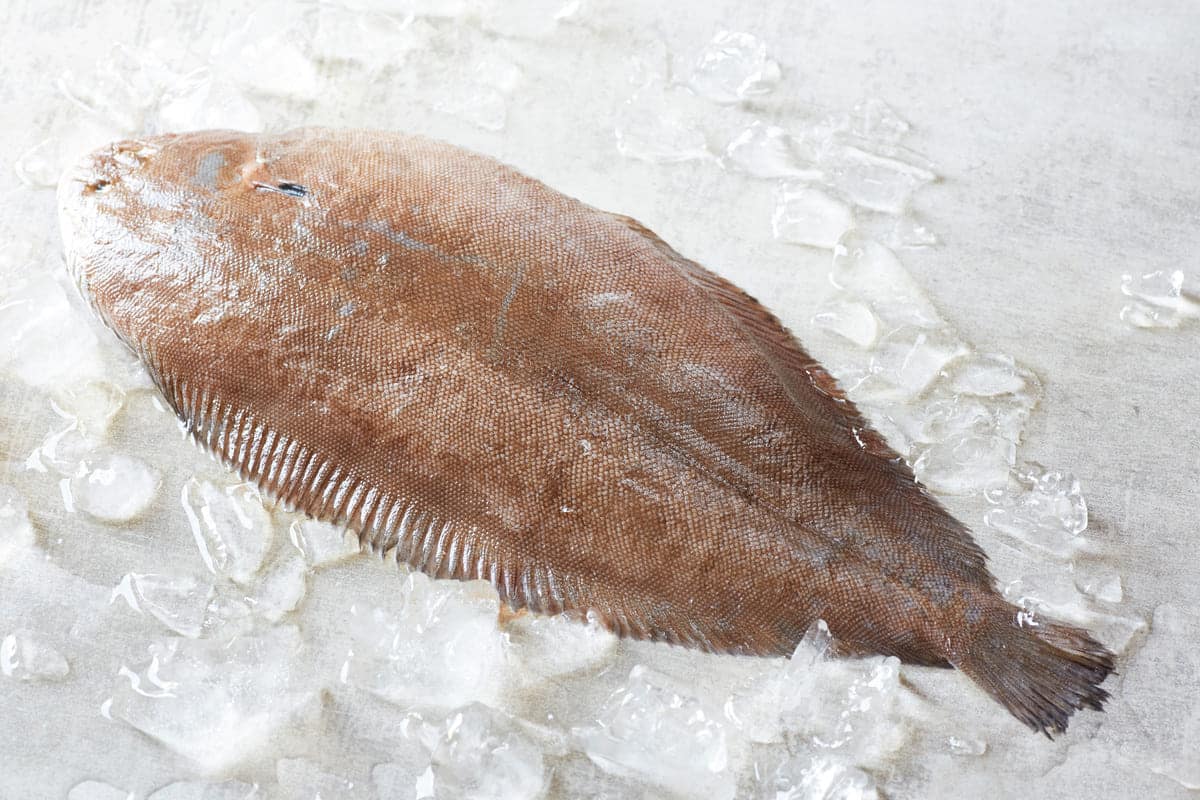
Distribution of Stocks
Dover sole is found in the continental shelf waters of recognised European land masses such as Norway, Senegal, England and the Mediterranean region and the North Sea. It inhabits shallow sandy, shelving, and weedy seabeds and is widely consumed due to its mild taste and delicate texture.
Commercial Fishing
Dover sole fishing is practised in various ways, such as bycatch from trawler fleets, bottom trawling, angling and aquaculture. These sustainable methods make Dover sole an attractive option for individuals looking to source their seafood responsibly.
Its popularity and versatility as a main ingredient in dishes that cover a range of cultural cuisines make it a timeless classic and a favourite among diners worldwide. Dover soles, marketed as either fillets or whole fish, are a popular addition to seafood dishes and are renowned for their flavour and relatively firm texture.
Due to its commercial value, however, there is a concern about overfishing in some areas, leading to the depletion of specific stock populations throughout its range. Therefore, responsible catch techniques and catch quotas should be practised by fishermen, and consumers should be mindful of where they buy their seafood.
Population
The Dover sole population is relatively stable, although a decrease in their population could be attributed to overfishing and bycatch in other fisheries. Fishing regulations advise anglers to target only larger and legal-sized Dover Sole to ensure the species’ longevity. Additionally, conservation efforts and monitoring commercial fishing operations are essential to ensure the population remains stable.
Conservation Efforts
By releasing undersized fish back into the ocean and reducing bycatch of other species, conservation efforts can help protect Dover Sole stocks. All fishing regulations and restrictions should be followed, and any gear should be designed with conservation in mind. These measures are essential to ensure sustainable populations of Dover Sole for future generations.
Conservation Status
The Dover Sole is currently assessed as Least Concern on the IUCN Red List. However, local populations can still be vulnerable to overfishing and habitat destruction, and it is essential to ensure the species’ long-term survival through sustainable fishing techniques.
Life Cycle of Dover Sole
The life cycle of the Dover Sole begins when adults spawn at sea. Eggs released by adults develop into larval fish, which feed and grow before undergoing a metamorphosis into juveniles. During this process, the Dover Sole develops its characteristic flat shape, with both eyes migrating to one side of its body.
After a period of transition, juveniles migrate to shallow coastal areas, typically in depths ranging from 15 to 50 meters, to complete their life cycle.
As the Dover Sole mature, they continue to move to progressively deeper waters, feeding and growing until maturity. The adults eventually reach sexual maturity, and the life cycle begins again.
Spawning Behavior
The spawning period of the Dover Sole typically occurs from April to late October. However, some spawning behaviour can occur year-round across southern parts of their distribution.
Adult Dover Sole gathers in large spawning aggregations to spawn during the night and under preferred temperatures of around 10C. During this process, the adults release batches of eggs and sperm, with females typically spawning more than once during a season, ranging from 1 to 5 times.
Taxonomy
Taxonomically, the Dover Sole is placed in the class Actinopterygii, with its order Pleuronectiformes, family Soleidae, and genus Solea.
The species name ‘solea’ comes from the Latin word solim, meaning ‘sole’, and the genus includes eight extant species and ten extinct species.
Dover Sole’s Diet
Dover Sole is an omnivorous species that feed on plants and animals. Its primary diet consists of invertebrates such as crabs, shrimp, worms, molluscs, small fish, plankton, and algae. It is a very active feeder, typically foraging during and late in the day when food sources are more available.
Its large teeth, particularly in the juveniles, can be used for crushing and grinding prey items, while its gill rakers (bristles surrounding the gills) filter small food items out of the surrounding water.
Culinary Uses
Dover sole is an ideal culinary fish due to its mild taste and delicate texture, as well as its perfect size, shape and consistent quality. It is usually sold in filleted form, as its flatness makes it one of the few flatfish species that may be filleted without risking damage to the flesh. Many chefs use it as an ingredient in their recipes, usually grilled, poached, baked or fried.
Nutritional Value and Health Benefits
Dover Sole provides a great source of protein, with 19g per 4oz serving, and has a low-fat, low-calorie content with a low-glycemic index, making it ideal for those on a restricted diet. It also contains essential Omega-3 fatty acids, vitamins and minerals such as phosphorous, calcium, magnesium, selenium, iron and Vitamin B12, which are all critical for maintaining a healthy nervous system.
Additionally, its Vitamin A, D and E content, essential minerals such as potassium, aiding electrolyte balance, can help keep blood pressure in control and strengthen bones.
Dover Sole is a wise choice for the health-conscious eater. It is low in calories and cholesterol, meaning it has the potential to provide considerable health benefits. Consequently, Dover Sole has remained a favoured seafood dish for those seeking to improve, or maintain, their health.
Taste and Texture
Dover Sole has a mild flavour compared to other fish species like cod or salmon, making it a delicious and versatile ingredient. Its delicate texture makes it prone to overcooking, so care must be taken not to overcook it. Furthermore, due to its subtle flavour, Dover Sole pairs well with almost any accompaniment and usually goes best with a sauce or herb topping.
Cooking and Preparation
The flavour of Dover Sole also depends on how it is cooked. Baking, grilling, sautéing and steaming all bring out the flavorful fish, making it an excellent addition to any dish.
Chefs throughout the years have praised the taste of Dover Sole for its mild and sweet flavour, contrasted by its slight oiliness when cooked. It is a highly versatile fish that can be incorporated into a wide range of dishes, making Dover Sole a fantastic addition to anyone’s meal, whether it is grilled, baked, or poached.
Popular Cooking Methods
Sauteing, baking, pan-frying, flash-frying, grilling, poaching, en papillote and steaming are all popular methods of cooking Dover Sole. Sauteing and pan-frying are commonly preferred methods due to their simplicity, as the fish cooks quickly and is best served when just cooked through.
Flash-frying is also possible and is optimal for cooking a whole fillet as it ensures that the delicate flesh remains tender. Baking is an excellent option for adding flavourings such as herbs to the fish, as in en papillote, with butter sauces or in combination with potatoes, vegetables and fruits.
Finally, boiling whilst it is useful for making soups and broth or for making fish stock as a base for other dishes.
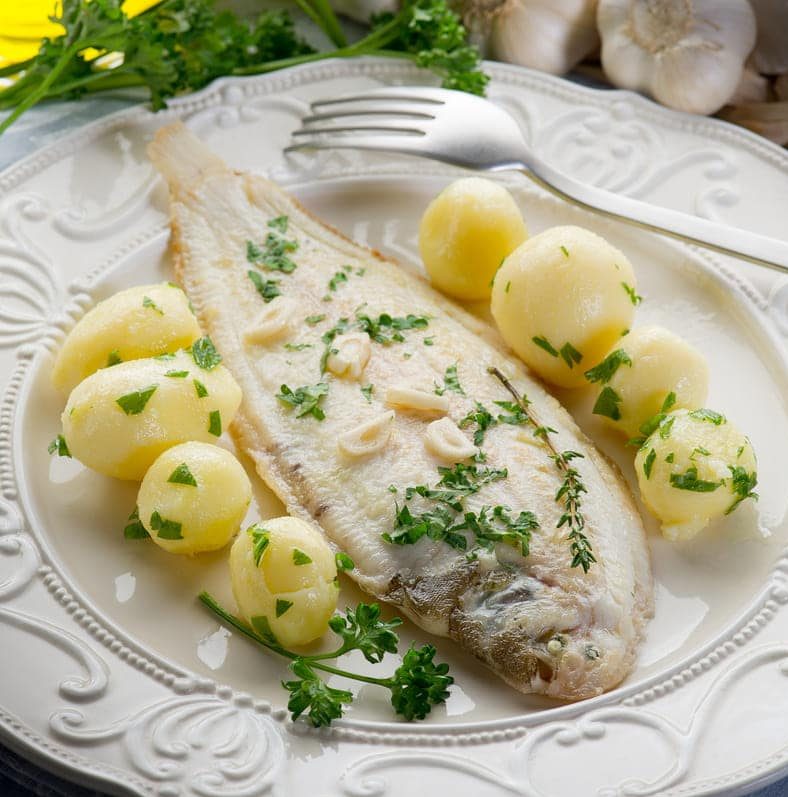
- Baking Method – Preheat the oven to 375 degrees Fahrenheit for baking the Dover Sole, and place the fillet in a greased baking dish with a tablespoon of butter, a dash of sea salt, and a teaspoon of lemon juice. Bake for 15-20 minutes, depending on size.
- Grilling Method – Grilling Dover Sole entails cleaning and oiling the grill grates, heating the grill to a medium-high temperature and then placing the fillet on the grates. Grill for 4-5 minutes per side or until the fish is thoroughly cooked.
- Frying Method – Wipe the pan clean first. Frying Dover Sole necessitates heating a large non-stick frying pan over medium-high heat and adding enough oil to cover the bottom of the skillet. Lightly dust with flour, then place the fillet in the skillet and cook for 2-3 minutes per side or until golden brown on both sides.
- Poaching Method – To poach the Dover Sole, bring a pot of water to a boil, then add a pinch of sea salt and carefully turn the heat to medium-low. Put the fish in the water and poach for a few mins or to your desired doneness.
- En Papillote Method – When cooking en papillote, preheat the oven to 350 degrees Fahrenheit, place each fillet onto a sheet of parchment paper and add desired toppings, such as herbs, butter, garlic, and lemon juice. Wrap up the fish and parchment paper on a baking sheet, and bake for 10-15 minutes or until the fish is nicely done.
- Steaming Method – To steam the Dover Sole, clean the fish, and dry it using paper towels before heating 1-2 inches of water in a pot, placing the steaming plate in the pot, and placing the fillet on top. Cover the pot, and steam the fish for 6-7 minutes or until the fish is fully cooked.
Classic Accompaniments
When serving Dover Sole as a main dish, a variety of side dishes pair perfectly with it. Fresh salads, grilled asparagus, roasted root vegetables, creamy mashed potatoes, zucchini noodles, oven-roasted sweet potatoes, squash gratin, spinach souffle, and sauteed Brussels sprouts are just a few of the traditional accompaniments that go well with Dover Sole.
To add bold flavours to the dish, add some herbs and spices such as chives, dill, thyme, flat leaf parsley, garlic powder, onion powder, cumin, or cayenne pepper. Sauces such as tarragon Beurre blanc, herbed butter, or a simple lemon-butter sauce can enhance flavour.
- Starchy Side Dishes and Bread Products- These make for excellent accompaniments to Dover Sole. Popular options include crusty bread, couscous, pilaf, risotto, and quinoa. Rich sauces such as béchamel, hollandaise, or cream sauces also pair nicely with Dover Sole.
- Additional Accompaniments – Other accompaniments that pair well with Dover Sole include capers, olives, sun-dried tomatoes, anchovies, and lemon wedges. These can be added to the dish to create a more varied and flavorful experience.
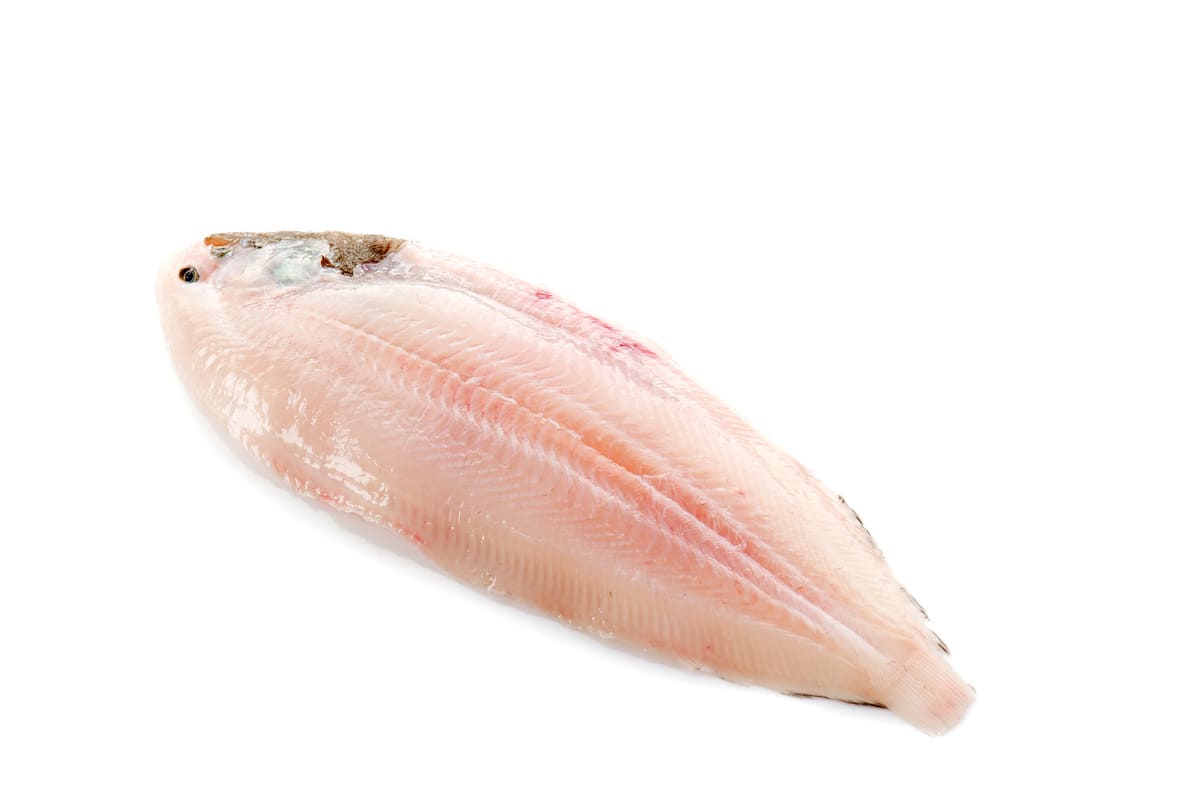
Popular Recipes
The versatility of Dover Sole makes it a popular accompaniment for classic British and French dishes – from Sole meuniere, served with a traditional melted butter and lemon sauce, to Dover Sole Goujons, which are covered in a light and crispy batter.
Pacific Dover Sole is also featured prominently in Asian cuisine, as its mild flavour makes it well-suited for sushi and sashimi.
Other popular recipes include Dover Sole with mushrooms, Dover Sole meuniere, baked Dover Sole, pan-fried Dover Sole, stuffed Dover Sole, fish stew dishes and ceviche marinades.
The delicate texture of Dover Sole also makes it an excellent choice for Christmas dinner dishes (as a substitute for salmon), barbecues and fish bouillon. It is also a low-fat and omega-3-rich fish, making it an excellent choice for health-conscious consumers.
Choosing and Serving Dover Sole
When selecting Dover Sole, prospective purchasers should look for vibrant, moist and tender white flesh with bright eyes, shiny skin, and a firm yet not gelatinous texture. Any excessive blackening should be considered a sign of an old fish.
Dover Sole is commonly presented as a whole, skin-on filleted fish and served with a classic combination of butter, capers, and parsley. Dover Sole can also be served pan fried, poached, or grilled.
Conclusion
Dover sole is a delicious and nutritious addition to any seafood kitchen, and its popularity continues to increase for its excellent flavour and firm texture. However, practising responsible fishing and purchasing habits is crucial to conserve the species and allow Dover sole stocks to rebound to healthier levels. With the correct catch and purchasing practices, Dover sole can offer diners a tasty and sustainable meal for years to come.
